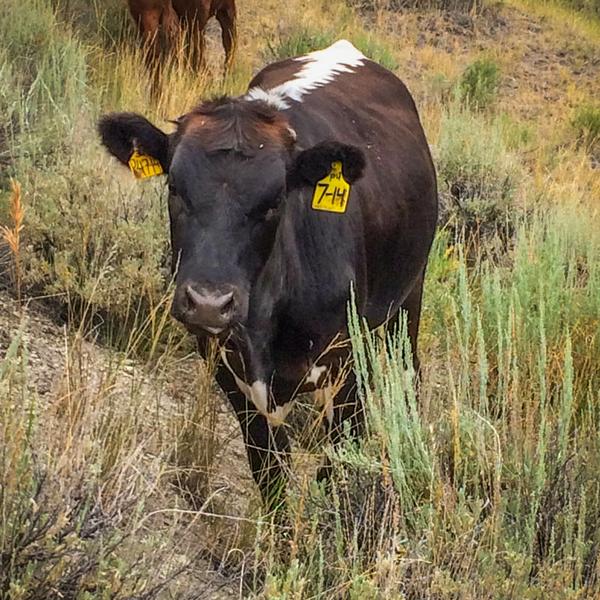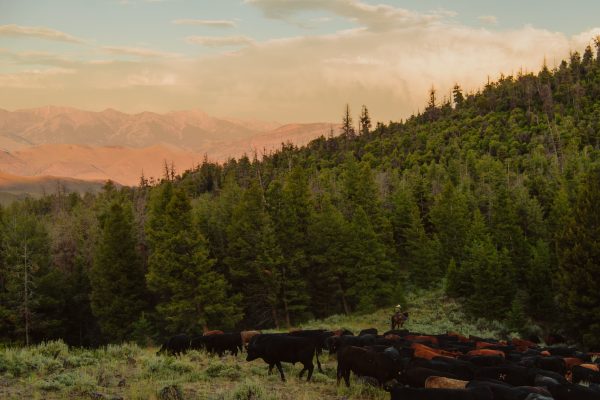
Skunky is a chronic problem child. He’s a distinctive Alderspring steer with a white stripe down the middle of his back, and is trouble with a capital Q for quitter. That’s what we cowboys call someone who leaves the herd for no good reason. He’s not a wild steer, by any means. He just wants to see what’s over that next hill”¦or in that dark timber yonder. He’ll talk that quitting trash to some unlikely accomplices: sweet eyed heifers (read teenage girls) that he’ll pied piper off into some distant dark beaver swamp (a haven for wolves).
He puts us on the alert. He and Brindle (a red striped back steer) are the markers in a gathered herd. If they are there, chances are good that all are. If not”¦time to press your heels into horse’s side and start beating that brush in search of steer and heifer.
It’s a 7000 acre pasture—a little over 10 square miles of broken forest, sagebrush and meadow, and a wayward steer will walk”¦and walk. This isn’t a walk in the park. Think Marathon. That leads me to the one truism that we discovered about our never quit presence with our beeves up on the range this summer. When we are with them, they eat. Peacefully. When we are not nearby, they just leave tracks. They stop eating and just walk. This dichotomy is quite exciting news for us, as it reinforces what I read in a paper by Dr. Fred Provenza, professor emeritus of Utah State. He interviewed and observed modern-day shepherds in the Southern French Alps around the area of Chamonix. It turns out that the sheep and goats herded by these shepherds in those alpine landscapes day after day gained weight better than animals left to their own devices back on the farm, even with high quality forage to choose from.
Could it be that they were actually accustomed to a shepherd partner that provided for them food choices in these wild settings, and therefore more comfortable when accompanied by a herder? In an adaptation sense, they certainly could be, as sheepherding, or livestock herding could indeed be the “oldest profession” that humans engaged in, and their animal partners had plenty of time to adapt accordingly to their human guardians and forage guides.
I’m thinking that we may have stumbled onto something quite profound, albeit lost to agriculture over the past 100 years. All of us cowboys and cowgirls herding (read shepherding) our beeves on the range full time have noticed a marked increase in growth and fat deposition on beeves living on the incredible plant diversity of those rough-clad rocky mountains. Our steers have always made their own table both on the range and at home, but with us as their husbandmen (and women), they are doing better than ever before.
We know of no one in the New World that is doing what we are trying here, and shepherding is not hugely common in very developed Europe. It is exciting to think that we may be able to take the wellness and flavor inherent in our beef to a new level simply by conditioning the beeves to our full time presence, and being part of the setting of their wild forage table.
Hopefully, with time, even Skunky and Brindle will find a little shred of genetic material that stimulates their instincts to bond with cowboys and cowgirls in wildcrafting the wellness of the remote Rocky Mountains.”‹







Mel
Interesting read . Seems like there is always one or two that want to explore over the hill . I read another of your stories about herding and wolves , where wolves were even close to camp . I wondered why you don’t thin them out ? They have no natural predator, so increase and become a nuisance . I know some say that’s wrong, but I recall David the shepherd boy and his experience with a wolf and a bear . He did what he had to , to keep his flock . I don’t know much but I also hunt for food , not trophy , and see the increase of wolves and cats today . I am just curious I guess .